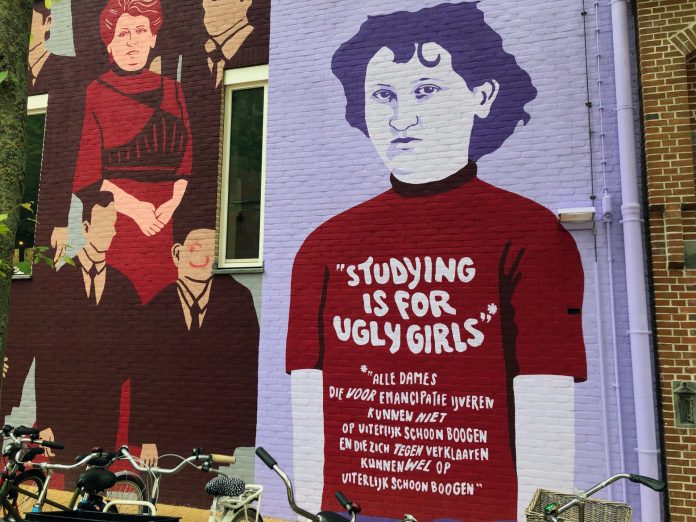Does the text ‘Studying is for ugly girls’ that’s painted on the new Aletta Jacobs mural confirm stereotypes, or is it a powerful statement meant to get people talking?
Marije Michel, associate professor of language learning at European languages and cultures, isn’t quite sure. ‘I was shocked when I saw it for the first time’, she says.
‘Now that it’s been explained to me, I understand it, and I can see the irony behind it. At the same time, I’m a little worried about young women who maybe aren’t that confident reading this and having the negative image they have of themselves confirmed.’
Judged by their looks
Artist’s duo VAAF, responsible for the mural, deliberately created a provocative image. ‘Just like Aletta was back then, women are still judged by their looks today’, says artist Jonna Bo Lammers.
‘When Aletta was first accepted to the university, a student from Leiden wrote an article on it’, she says. ‘He cowardly dances around the issue, but he basically said that the only reason Aletta wanted to go to university was because she was ugly.’
The two young women at VAAF wanted to include that side of Aletta’s story in their artwork. ‘That line, “Studying is for ugly girls”, is so absurd in today’s context that putting it on a t-shirt can’t be anything other than a joke. It was our intention to subvert it and make the words powerful.’
Painful
Michel isn’t sure if this is the way to go about, though. ‘I contacted a few people at the arts faculty and received mixed responses. The majority disliked it, and thought it was painful. All the women I’m friends with who are professors or want to be professors said it left a bitter taste in their mouth’, she says.
The new mural, several metres high and on the wall next to the UB, is in a location in the city centre that thousands of people walk by every day. The text is written in giant letters on the t-shirt that Aletta Jacobs is painted as wearing.
According to Michel, it may not be academically responsible to confront young women with the text every single day. ‘I think the focus on girls’ and women’s look is problematic, and research has shown that slogans on t-shirts confirm stereotypes.’
Get people talking
At the same time, Michel also realised that it’s a work of art that impacts people and is doing exactly what the artists had in mind: get people talking.
‘This is exactly what we do in the humanities: we study language, media, and critical discourse, and this piece enables us to use our expertise to shine a light on that.’
That’s why the faculty will be organised a round-table discussion about the mural during the Arts Festival in September. ‘We’ll be talking about what the mural contributes to the public space.’
Context
Michel wouldn’t go so far as to suggest that the artwork be changed. ‘Art belongs to the artists’, she says. ‘But it would’ve been nice for there to be more context.’
There was in fact supposed to be more context, says artist Lammers. ‘There’s going to be a sign in English that explains everything about the mural. It will say that the statement is something she heard being said a lot, and that it’s on her t-shirt as a form of protest.’
If it had been up to VAAF, that sign would have already been installed during the unveiling of the mural. ‘Unfortunately, we’re not responsible for organising this project.’
What if the sign fails to properly explain the context? ‘We’re definitely open to making adjustments. Our intention is to give new meaning to the statement, not to insult Aletta Jacobs.’




